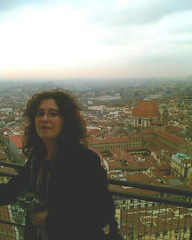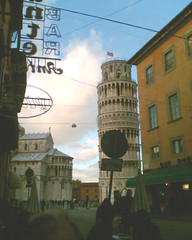 I used to have an Old English Sheepdog called Florence (1984-96), who was scruffy and bouncy and liked to chase balloons. She was in no way like the city of the same name, from which myself, the Dr and my parents have just returned.
I used to have an Old English Sheepdog called Florence (1984-96), who was scruffy and bouncy and liked to chase balloons. She was in no way like the city of the same name, from which myself, the Dr and my parents have just returned.It’s a slap-in-the-chops of a beautiful city, even in drizzle and downpour. The first thing we did was clamber the more-than-400 steps to the top of Brunelleschi’s Duomo – a knackering mountaineer round and over and up through the workings, where it’s best not to dwell on the 15th-century-ness of the wonky zigzag brickwork.
Younger folk from other lands pushed past us back and forth up the haphazard corridor. I thought fondly of their being whipped and eaten by the monsters on the dome’s underside. Perhaps I was just feeling hungry.
 Then, pop we were out into the tiny walkway on the roof of the world, looking out on to rooftops of the early Renaissance. Such a splendid vista that the usual vertigo forgot to kick in. The crappy o’erhanging sky leant it Turneresque grandeur, and we ahhed and cooed and took photos.
Then, pop we were out into the tiny walkway on the roof of the world, looking out on to rooftops of the early Renaissance. Such a splendid vista that the usual vertigo forgot to kick in. The crappy o’erhanging sky leant it Turneresque grandeur, and we ahhed and cooed and took photos.After late lunch and a bit of a wander, we continued to explore. The Baptistery reminded me of the Pantheon in Rome, and the Museo dell’ opera del Duomo contained all sorts of pretty things mostly brought in from the rain. Michelangelo’s Florentine Pieta is very different from his Rome one – this Jesus is bigger than those around him.
What’s more, it’s unfinished (because he broke it), so lets you see how the master worked. The trick to sculpting seems to be to start with a crude outline then gradually work in the detail.
Like with CGI, I told the Dr. She eyed me with one of those looks.
The next few days we criss-crossed the city, and even managed a trip out to Fiesole, where we clambered round the Roman theatre and I fell fast asleep on the bus. It occurred to me on the waterfront how much Florence now might resemble 1599 London, as given in the book I was reading.
Almost everywhere was acknowledging 40 years since a terrible flood, which did untold and awful damage to so many pretty old things. Black and white blow-ups of photograph showed church floors and cloisters and delicate bits of art covered all over in mud. Crude English captions brokenly explained that the real battering came not from the water, but from the diesel and engine oils mixed in with it, from the tens of thousands of cars caught up in the deluge.
Despite everything we’d been told, there was no queue into the Uffizi, and we marvelled at the Botticellis which the Dr so adores. There was a general pre-Raphaelite thing going on in the works of art she clung to. I was more struck by why "Florentine" is sometimes a synonym for "Can’t catch" – there’s willies every whichway you look.
What would be the collective noun for willies? "Wilkin" suggests the Dr. I’m going to vote for "Thatch".
There’s something of a giveaway in the works of Michelangelo. Even his unfinished men have perfectly polished torsos, while the women in the Medici Chapel look like men with blocky lumps… For such a keen observer of the physical form, he just didn’t have an eye for the ladies.
Of far more excitement to me was the Masaccio frescoes in the Santa Maria Novella and the Santa Maria del Carmine. 100 years before Michelangelo and da Vinci, Masaccio was painting some really cool things.
In his Trinity, he's playing with new-fangled linear perspective and making things freakishly stand-out - the 1427-28 equivalent of movies in lurid 3D. Only being used to pretty a church.
In a time of stylised, two-dimensional Byzantine stylings (which are all very nice in their way), he was basing his work on observation, using natural colours and a realistic feel. The characters in his pictures are real people, with emotional complexity writ large in their faces. I was especially taken with the photographic feel of some of the peripheral guest cast.
It’s a century ahead of the times to have individuals so real and distinctive. In the Branacci Chapel, St Peter is recognisable in a whole series of frescoes – as much to do with a recognisable head even in different poses, as because he's always wears the same colours.
"The rendering of the tribute money" also splits time up to create a narrative flow: in the centre, Jesus points Peter off to the left, where he’ll find a fish full of money, and where Peter already fishes. On the right, we see Peter handing over the miraculous cash to some bloke who is strapped for his taxes.
The only way to understand the picture is to read the story, by recognising the characters and their place in time. Long before I’d read Scott McCloud, I wrote an A-level essay on this early comic-strip form, based on how it met the strictures of “How to Draw Comics the ‘Marvel’ Way”.
I told the Dr. She eyed me with one of those looks.
On our last day, we managed the English Cemetery, where the Dr found a like-mind to discuss sneaky plans with.
 We then took a train to Pisa, which crawled maggot-like from stop to stop so that we thought we’d miss our flight. Had just enough time to cab it to the wonky tower made famous in Superman III, stuff some Calzone and ignore the hawkers of watches, and then cab it back across the river to the airport.
We then took a train to Pisa, which crawled maggot-like from stop to stop so that we thought we’d miss our flight. Had just enough time to cab it to the wonky tower made famous in Superman III, stuff some Calzone and ignore the hawkers of watches, and then cab it back across the river to the airport.Back home, via a just-missed train in East Croydon - those last six words a very poem of despair - to the cat and post and a quick-thinking use of Tsan. And the embrace of work like we'd never been parted.









3 comments:
An Enfeeblement of Willies.
Unless there are more than 500, which is known as a "Gillat".
Two 't's, thanks.
A chap of willies.
Post a Comment